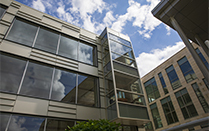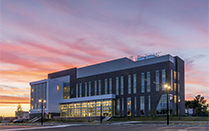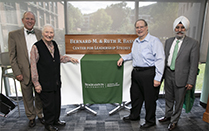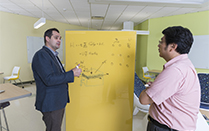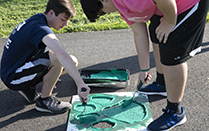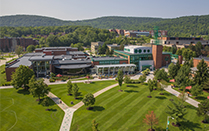Information Technology Services activities
This past quarter Information Technology Services (ITS) reorganized to address expressed institutional needs, executed various technological infrastructure upgrades and continued to focus on customer service to the University.
Creation of Enterprise Systems
As an action item from the Gartner Risk and Security Assessment and to address the growing technology needs of Binghamton University, ITS reorganized to form the Enterprise Systems group. The Enterprise Systems group was to increase agility and improve services associated with database administration, systems-developed integration and system administration functions.
Projects and initiatives of Enterprise Systems will include:
• Gathering better performance data for ITS systems.
• Deploying an identity and access management solution.
• Developing a disaster recovery solution for VMWare.
• Developing a cloud strategy for the University, in conjunction with Enterprise Applications.
National Science Foundation grant collaboration
The Campus Cyberinfrastructure program of the National Science Foundation (NSF) invests in data, networking and computing infrastructure capabilities at and across institutions of higher education. In this quarter, ITS responded to a call for submissions with three (3) proposals to three (3) different areas of the NSF campus cyberinfrastructure program.
In conjunction with Stonybrook University, the University of Albany and the University of Buffalo, ITS and the Department of Computer Science led a Binghamton University response for a multi-institutional NSF proposal. The goal of this SUNY University Center collaboration is to design and implement a shared infrastructure named SUNY STAC (Science, Technology and Collaboration Network) based on a common and consistent technical standard. The shared infrastructure would be comprised of shared data storage managed via a high bandwidth, low-latency dedicated network.
Binghamton University also collaborated with NYSERNet, Vassar College, SUNY Oswego, SUNY Geneseo and Rochester Institute of Technology to submit a proposal seeking support for researchers. If funded, NYSERNet would create a Cyber Team that would provision support directly to faculty researchers within the partner institutions. The Cyber Team would be composed of staff with domain-specific expertise; knowledge of advanced computational methods; experience engaging national, regional and campus-based advanced cyber infrastructure; and outstanding facilitation skills. This team would be dedicated to facilitating and accelerating adoption and successful utilization of advanced computational methods by researchers at New York state colleges and universities.
Lastly, ITS submitted a grant focused on acquiring appropriate cyber infrastructure resources in support of research which at Binghamton University is transitioning toward increased external and geographically indifferent collaborations, increased reliance on cloud-based high performance computing and utilization of mass data sets. Such research is hampered by limited external connectivity currently available to researchers and this proposal seeks to fund EREC-CI, or Enhanced Research and Education Connectivity for Collaboration and Instruction. The increased connectivity via a Science DMZ would allow faculty and students to access increased computational, data and collaborative research resources.
Customer service initiatives
Information Technology Services made improvements to technology services throughout the last quarter. This included the renaming of Connect2BU to Welcome2Bing and the renaming of bugaming to mydevicesbing. These new network names allow users to more easily understand and identify what network to connect to at Binghamton University.
The Help Desk was open during new student Move-in Day to help with technical issues and received 776 tickets during Move-in Week. Prior to Move-in Day, ITS staff was on hand to talk to new students and parents at all orientation sessions, including at the Campus Services Fair and math exam.
Many updates were also completed in the public computing areas across campus, including new computer images and software for the PODS classrooms. In addition, the PODS, Information Commons and multimedia computers were upgraded to Office 2016 before the start of the fall semester. The ITS student staffing model was redesigned for the public computing spaces to provide better service to students who access these resources.
Collaboration across the University included the completion of the Decker Electronic Health Record simulation system that was deployed for use this fall semester, and continued work on the integration of the new School of Pharmacy and Pharmaceutical Sciences systems into our existing systems, including Slate and Banner. ITS also worked with the Libraries to provide systems support during a staffing transition as well as supported the upgrade of the Rosettta application. A project to virtualize the Longcapa application for the Chemistry Department was also completed with great success as was work to prepare the Thomas J. Watson School of Engineering and Applied Science mainframe with requested virtual environments to support fall-semester courses.
Other ITS projects and operational activities included:
• Implementation of a new DVS Analytics call recording system for the University Call Center
• Extensive research and testing on two enterprise-level physical security solutions for the University
• Implementation of three new campus core router/switches
• Installation of new certificate for busecure
• Student SSL VPN termination moved to the Student Virtual Routing Forward to increase security
• Move of all resident hall switches to new non-routable management IPs
• Implementation of KMS server for MS Office 2016 licensing for domain computers
• New VDI 18 seat lab for Call Center operations
• New VDI 20 seat lab to support SOM specialized software (SAP Client)
• Upgrade of Labstats for POD computer statistics
• Update of over 100 servers with security and operating system updates
• Configuration of load balancer and SSO to allow for expansion and high availability
• Commencement of the upgrade of nearly 25 Linux servers to newer, supported operating environments
• Began testing AWS for the migration of the University website to this new environment
• Upgrade of the Web Checkout process for the Center for Learning and Teaching
• Migration of seven databases off of a server, including the University calendar; elimination of a single point of failure in the main campus web environment
• Creation of over 25 new virtual servers for test, development and production environments
• Upgrade of eVisions and Form Fusion environment
• Bringing new VMWare ESX M100E chassis and Blade infrastructure online
